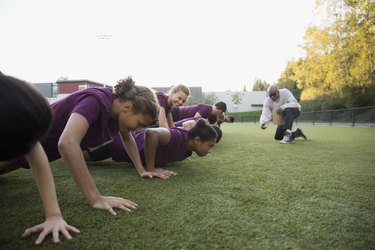
Getting strong as a 15-year-old boy or girl isn't just about trying to build huge muscles. It's also about learning proper exercise form and technique.
At this age, particularly during puberty, the focus should be on mastering the basics, working with your body type and gaining strength safely.
Video of the Day
Video of the Day
Keep the Focus on Strength
The first thing to understand about getting strong as a 15-year-old is that puberty factors into muscle growth. Before a teenager hits the later stage of puberty, they don't have the hormone levels, like testosterone, required to build muscle mass.
This later stage of puberty comes about at different rates for teenagers. At age 15, some teens will still be in the early stages of development. For instance, many boys' voices don't deepen until they get older, as their overall growth hasn't hit its peak. For others, puberty continues through their late teens and even early 20s.
Also, according to the American Academy of Pediatrics, girls tend to develop sooner than boys. Whereas girls experience rapid growth between the ages of 11 and 12, boys tend to hit puberty a couple of years later.
Thus, going to the gym, while healthy for a teenager, is going to have different desired outcomes than it would for adults. Because teens' bodies are still developing at age 15, the focus should be on gaining strength rather than building big muscles.
Read more: Why Is Exercise Important to Teenagers?
Proceed With Caution
A lack of testosterone isn't the only reason to avoid heavy lifting as a teen. A teenager has sections of cartilage called growth plates inside the ends of their bones. Growth plates are more delicate than the surrounding bones, muscles, tendons or ligaments, as well as weaker during periods of rapid growth.
Stanford Children's Health reports that too much weight may stress or damage the joints and ligaments, or even separate growth plates in a teen's growing body. Focusing on weight training and muscle strengthening rather than heavy lifting will help teens limit the risk of injury.
It's also important to partake in proper nutrition as a teenager, particularly after a weight lifting session. The Academy of Nutrition and Dietetics says active teens need about 0.45 to 0.6 grams of protein for each pound of body weight. In addition, eat a balanced diet that includes whole grains, healthy fats (such as avocado or olive oil) and a variety of colorful fruits and vegetables.
Strength Training for 15-Year-Olds
The Physical Activity Guidelines for Americans recommend that children 6 to 17 years old get at least 60 minutes of physical activity a day, as well as muscle-strengthening activity at least three days a week. The following exercises will help you incorporate your recommended minutes while getting strong as a 15-year-old boy or girl.
During each set, perform an average of eight to 15 repetitions of any particular exercise. Repeat for about three or four sets. This should take a total of 20 to 30 minutes. Here are several exercises to consider trying:
- Chest: Barbell or dumbbell bench press and incline bench press, dumbbell fly, chest dips, push-ups
- Back: Lat pull-downs, barbell or dumbbell rows, pull-ups, seated cable rows, deadlifts, dumbbell shrugs
- Quadriceps: Sumo and front squats, leg press, reverse and forward lunges, hack squats, goblet squats, machine leg extensions
- Hamstrings: Belly-down hamstring curls, straight-leg deadlift, good mornings
- Shoulders: Arnold press, side lateral raises, front raises, upright rows, military press, seated dumbbell or barbell press
- Arms: Bench dips, overhead dumbbell extensions, triceps dumbbell kickbacks, cable triceps extensions (for triceps), barbell or dumbbell curls, hammer curls, preacher curls, chin-ups (for biceps)
- Abs: Sit-ups, bicycle twists side to side, leg raises, Russian twists, planks
Note that you can incorporate body weight, weight machines, resistance bands, dumbbells and barbells. Just mix and match so you're doing different types of exercises. You may also wish to focus on one muscle group at a time on varying days. Or, you can make it a full-body workout and choose exercises from each muscle group.
Read more: The Average Weight Bench Press for a 15-Year-Old
- American Academy of Pediatrics: "Effects of Puberty on Sports Performance: What Parents Need to Know"
- Stanford Children's Health: "Weight Training for Teens"
- U.S. Department of Health & Human Services: "Physical Activity Guidelines for Americans"
- Teens Health from Nemours: "Strength Training"
- Academy of Nutrition and Dietetics: "How Teen Athletes Can Build Muscle with Protein"